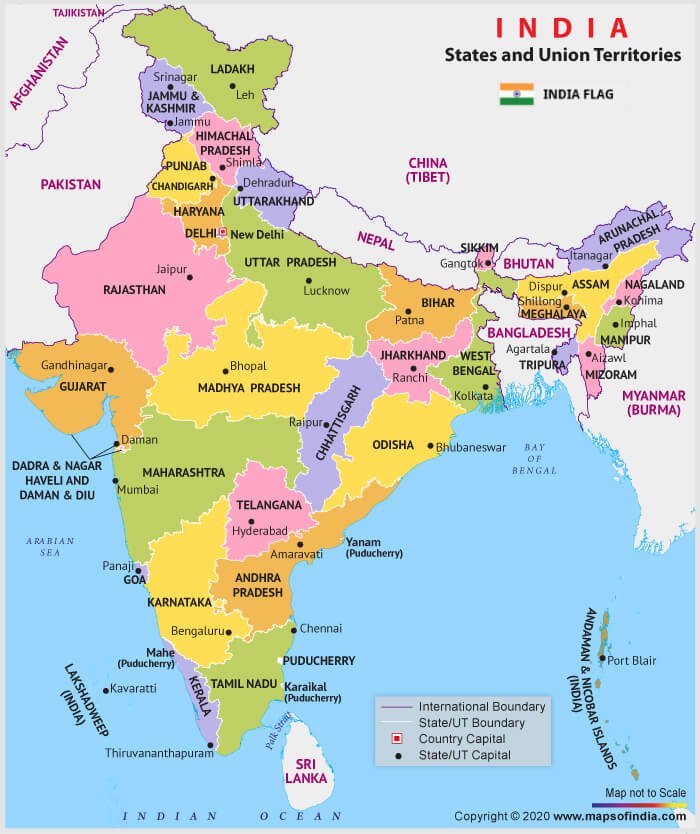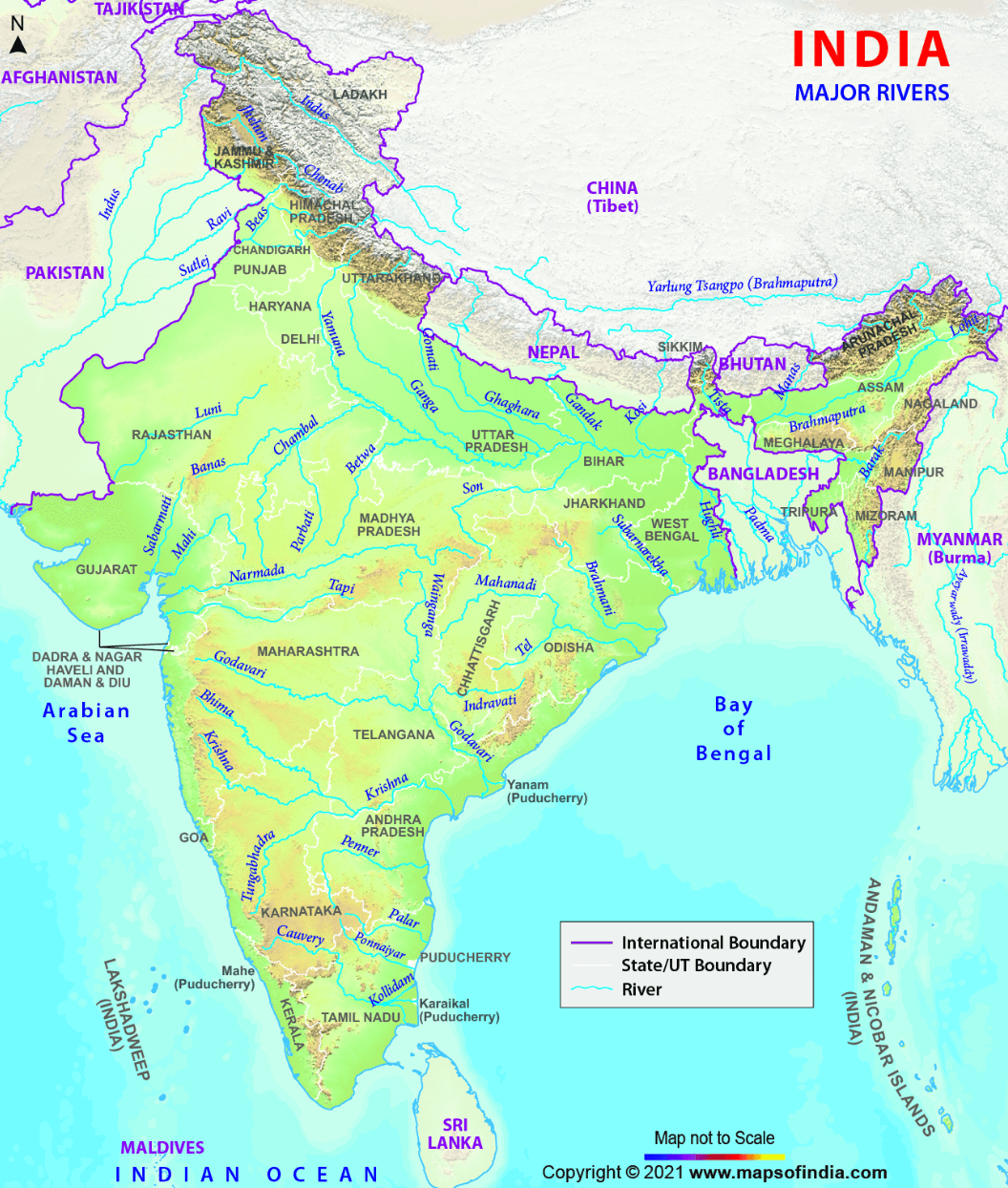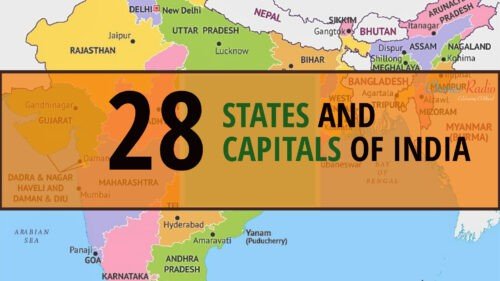India stands as the 7th largest country globally and ranks as the 2nd most populous nation. Its diversity and cultural wealth are emblematic, comprising 28 states and 8 Union territories, each possessing distinctive identities, histories, and administrative hubs. Positioned in southern Asia, India operates under a parliamentary form of government. Given its vastness, managing such a large country from a centralized location becomes arduous. Thus, the Indian Constitution grants the central government the authority to configure states as deemed suitable. This article endeavors to provide an overview of Indian States and their Capitals, underscoring their significance and contributions to the nation’s tapestry.
Indian States and Capitals of India
Understanding the total count of States and Union Territories in India along with their respective capitals often escapes many. In this article, we provide the latest update on India’s States and Capitals. Presently, India comprises a total of 28 states and 8 union territories.
Each Indian state holds administrative, legislative, and judicial capitals, while in some, these three functions occur within a single capital. Every state is governed by a Chief Minister. Here, we’ve compiled a comprehensive list of Indian States, Union Territories, and their respective capitals.
Indian States and Capitals List
India stands adorned with a total of 28 states and 8 union territories, each contributing to the vibrant cultural tapestry that enriches and energising the country’s identity. Here’s a concise list of the 28 Indian States and their respective capitals.
| State Name | Capital |
|---|---|
| Andhra Pradesh | Amaravati |
| Arunachal Pradesh | Itanagar |
| Assam | Dispur |
| Bihar | Patna |
| Chhattisgarh | Raipur |
| Goa | Panaji |
| Gujarat | Gandhinagar |
| Haryana | Chandigarh |
| Himachal Pradesh | Shimla |
| Jharkhand | Ranchi |
| Karnataka | Bengaluru |
| Kerala | Thiruvananthapuram |
| Madhya Pradesh | Bhopal |
| Maharashtra | Mumbai |
| Manipur | Imphal |
| Meghalaya | Shillong |
| Mizoram | Aizawl |
| Nagaland | Kohima |
| Odisha | Bhubaneswar |
| Punjab | Chandigarh |
| Rajasthan | Jaipur |
| Sikkim | Gangtok |
| Tamil Nadu | Chennai |
| Telangana | Hyderabad |
| Tripura | Agartala |
| Uttar Pradesh | Lucknow |
| Uttarakhand | Dehradun (Winter)<br>Gairsain (Summer) |
| West Bengal | Kolkata |
Indian Union Territories and Capitals
India currently encompasses 28 States and 8 Union Territories. The former state of Jammu and Kashmir has been restructured into two Union Territories, namely J&K and Ladakh. This restructuring was enacted through a reorganization act passed by the Parliament on 5-6 August 2020. Presently, India comprises 8 Union Territories.
| Union Territories Name | Capital |
|---|---|
| Andaman and Nicobar Islands | Port Blair |
| Chandigarh | Chandigarh |
| Dadra & Nagar Haveli and Daman & Diu | Daman |
| Delhi | New Delhi |
| Jammu and Kashmir | Srinagar (Summer) |
| Jammu (Winter) | |
| Lakshadweep | Kavaratti |
| Puducherry | Pondicherry |
| Ladakh | Leh |
Indian States with Their Specialities
Each Indian State boasts a distinctive historical and cultural background, contributing a tapestry of specialties to the nation. For instance:
New Delhi, India’s Capital: Blending modernity with history, New Delhi is adorned with iconic landmarks like India Gate and the Istana, symbolizing the country’s past challenges and its promising future.
Mumbai, Maharashtra: Serving as the financial and entertainment hub, Mumbai houses Bollywood and India’s largest stock exchange, portraying a vibrant fusion of financial prowess and cinematic glory.
| Indian States | Specialization |
|---|---|
| Andhra Pradesh | Renowned for its spicy cuisine, historical sites like Charminar, Golconda Fort in Hyderabad, and rich cultural heritage. |
| Arunachal Pradesh | Known for breathtaking landscapes, diverse tribal cultures, and the grand Tawang Monastery. |
| Assam | Famous for tea plantations, Kaziranga National Park, Bihu dance, and traditional silk weaving. |
| Bihar | Historical significance with ancient cities like Patliputra, Buddhist pilgrimage sites, and Madhubani art. |
| Chhattisgarh | Recognized for tribal heritage, mineral resources, and the awe-inspiring Chitrakote Waterfall. |
| Delhi | Home to iconic landmarks signifying India’s history and future aspirations, such as India Gate and the Istana. |
| Goa | Beautiful beaches, vibrant nightlife, a blend of Indian and Portuguese cultures, and delectable seafood cuisine. |
| Gujarat | Industrial and business prowess, vibrant festivals, the Rann of Kutch, and the historic Sabarmati Ashram. |
| Haryana | Known for agricultural productivity, industrial centers, and Chandigarh, a well-planned architectural marvel. |
| Himachal Pradesh | Renowned for picturesque hill stations, adventure tourism, serene landscapes, and the residence of the Dalai Lama. |
| Jharkhand | Abundant in mineral resources, rich tribal culture, and the Betla National Park. |
| Karnataka | Dubbed the “Silicon Valley of India” for its IT industry, historical sites like Hampi, and classical dance forms. |
| Kerala | Backwaters, Ayurveda, lush greenery, and the highest literacy rate in India. |
| Maharashtra | Financial and entertainment hub, Bollywood, historical landmarks like Gateway of India, and culinary delights. |
| Manipur | Known for traditional dance forms, Loktak Lake, and vibrant festivals. |
States and Capitals of India Map
You can check the latest political map of India which provides the total number of states and union territories in India and their capitals at present.

States and Capitals of India – River Map
The Indian River system is classified into two primary categories based on their source: the Himalayan Rivers and the Peninsular Rivers. The Himalayan Rivers originate from the Himalayas, traversing through the Northern Plains, while the Peninsular River System, also known as Peninsular Drainage, emerges mainly from the Western Ghats.
The major Himalayan River systems include The Indus River System, The Ganga River System, The Yamuna River System, and The Brahmaputra River System.
On the other hand, the major Peninsular River Systems encompass Mahanadi, Godavari, Krishna, and Cauvery.

States, UTs and Capitals of India: Important Points
Understanding the distinction between a state and a union territory is vital. Among the eight union territories in India, three have their own legislatures—Delhi, Puducherry (formerly Pondicherry), and Jammu and Kashmir. Both states and union territories have their respective capitals.
| States | Union Territories |
|---|---|
| Has its own administrative units with an elected government. | Constituent units controlled and administered by the Central Government. |
| The Governor serves as the Executive Head. | The President acts as the Executive Head. |
| Relationship with the Centre is Federal. | Unitary relationship with the Centre, consolidating power in the Union’s hands. |
| Administered by the Chief Minister elected by the people. | Administered by an Administrator appointed by the President (except for Delhi, Puducherry, and Jammu & Kashmir). |
| Cheif Minister holds the primary authority. | The Lieutenant Governor holds the primary authority. |
States and Capitals of India: Latest Updates
Before diving into the Union Territories and their capitals, let’s catch up on the recent updates about UTs.
As of 26th January 2020, India had 8 union territories. Notably, the U.T. Daman and Diu, along with Dadra and Nagar Haveli, were merged to form a single union territory.
On August 5, the central government announced the abrogation of the special status granted to Jammu and Kashmir under Article 370, leading to its division into two Union Territories: Jammu and Kashmir, and Ladakh.
The merger of Daman and Diu with Dadra and Nagar Haveli has subsequently reduced the number of UTs to eight.
Recommended Articles
Largest Longest Tallest Biggest things in India till 2024 Which Everyone Should Know
Largest City in India: Top 10 Biggest Cities In India By Area
List of Top 10 Richest People in the World 2024 – Billionaires List
List of Most Polluted Cities in the World, 3 Cities are in India
Largest Rivers in the World, List of 10 Largest Rivers in the World
Complete List of States and Capitals of India – 28 States and 8 Union Territories
